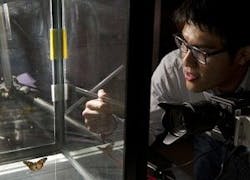High-speed cameras capture a vision of painted ladies in flight
Engineers at Johns Hopkins University (Baltimore, Maryland, USA) have been using high-speed video cameras to capture images of butterflies in flight in the hope of understanding how they might be able to mimic their maneuvers in the design of micro aerial vehicles (MAVs).
For military missions, MAVs must be able to fly successfully through complex urban environments, where there can be tight spaces and turbulent gusts of wind. But current MAVs presently lack the maneuverability to do so.
To address that shortcoming, Tiras Lin, an engineering undergraduate has been using a high-speed video system to look at how changes in mass distribution associated with the wing flapping and body deformation of a flying insect help it engage in rapid aerial twists and turns.
The system itself comprises three video cameras capable of recording 3000 1-Mpixel images per second. These were anchored in fixed positions and focused on a small region within a dry transparent aquarium tank.
For each analysis, several butterflies were released inside the tank. When a butterfly veered into the focal area, Lin switched on the cameras for about two seconds, collecting approximately 6000 3-D views of the insect’s flight maneuvers. From these frames, Lin typically homed in on roughly one-fifth of a second of flight, captured in 600 frames.
The arrangement of the three cameras allowed the researchers to capture three-dimensional data and analyze the movement of the insects’ wings and bodies in detail.
From their studies, the researchers have already discovered that changes in moment of inertia, which is a property associated with mass distribution, plays an important role in insect flight, just as arm and leg motion does for ice skaters and divers.
The findings run contrary to earlier research that erroneously concluded that changes in spatial distribution of mass associated with wing-flapping did not need to be considered when analyzing an insect’s flight maneuverability and stability.
The insect flight dynamics research was funded by the US Air Force Office of Scientific Research and the National Science Foundation.
-- By Dave Wilson, Senior Editor, Vision Systems Design

